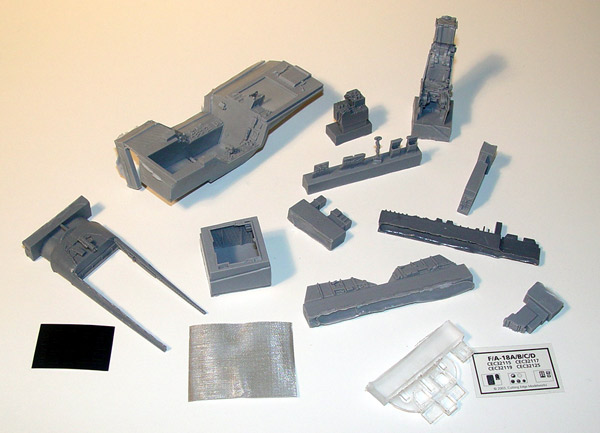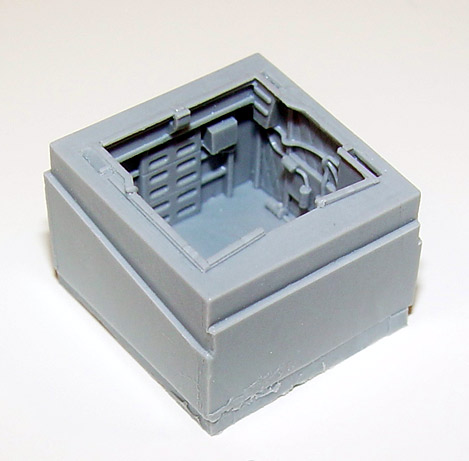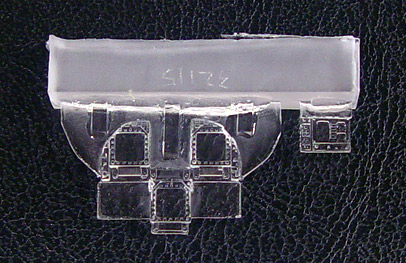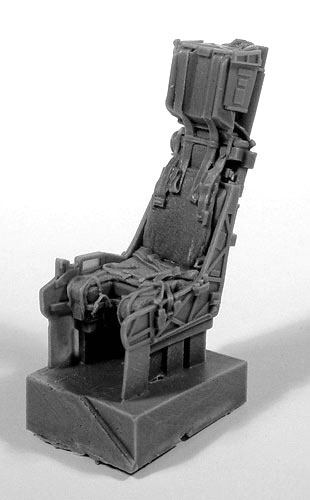|
F/A-18C Hornet
1/32 Scale Cockpit

Cutting Edge Modelworks
S u m m a r y
|
| Catalogue Number
and Description |
CEC32115 - Super Detailed
Cockpit for Academy 1/32 Scale F/A-18C Hornet |
| Scale: |
1/32 |
| Price: |
USD$31.99 from Meteor Productions
Website |
| Contents and Media: |
35 parts in resin; small clear
acetate sheet with printed instruments; wire mesh; BlackMagic mask |
| Review Type: |
FirstLook |
| Advantages: |
Excellent casting and detail.
|
| Disadvantages: |
None |
| Recommendation: |
Recommended |
Reviewed by Dave Williams

HyperScale is proudly sponsored by Meteor
Productions
For those looking to dress up their 1/32 Academy F/A-18C Hornet kit,
Cutting Edge offers the first in a series of cockpits designed for the new
kit.
Although the kit cockpit looks pretty good, molding and financial
considerations limit the amount of detail that the manufacturer of a
standard production injection molded kit can supply. For those who want
something more, aftermarket companies can provide accessories that surpass
what can be achieved by injection molded technology alone and give the
modeler something much closer to a scaled down version of the real thing.
Before moving on to the contents of the CE set, a little digression
into what aircraft this set is appropriate for might be in order:
Early vs. Late, Blocks, Lots, and so on
Hornet production is broken up into a series of production blocks, with
the blocks purchased in a number of lots. A specific aircraft Bureau
Number identifies that aircraft as part of a particular block and lot. The
CE ďlateĒ cockpit represents a Lot 19 aircraft, which starts at BuNo
165207 and is a part of Production Block 50. For those who have lost their
secret Hornet production decoder ring, here is a link to a handy web page
that breaks down F/A-18C production: http://home.att.net/~jbaugher4/f18_7.html
While this discourse on blocks and lots is interesting, most modelers
simply want to know which cockpit set they should get for the particular
aircraft they want to build. Although there are undoubtedly some
differences between the cockpits of various blocks, the main item of
practical interest to most modelers is which ejection seat is appropriate
to the aircraft they want to build. Aircraft prior to BuNo 164196 (Lot 13,
Block 32) used the SJU-5/6 seat and subsequent aircraft use the SJU-17
NACES seat.
As this set contains the SJU-17 seat, modelers who donít want to get
caught up in the block/lot frenzy may wish to consider simply using this
set for aircraft for US aircraft with a BuNo of 164196 and above. CE makes
set CEC32117 with the SJU-5/6 seat for who want to make an earlier
F/A-18C.
The Cutting
Edge 1/32 Scale F/A-18C Cockpit
|
The main components of this set consist of 35 resin parts that mostly
replace the Academy kit cockpit parts. The set also includes a small clear
acetate sheet with printed instruments, a piece of wire mesh to represent
the RFI netting over the equipment bay behind the seat, and a small set of
BlackMagic masks for the CRTs on the instrument panels. The only parts
reused from the kit cockpit are the ejection pull ring, the HUD frames and
glass, and bits of the canopy actuating mechanism.
Overall, the casting quality and level of detail is excellent. The
improvement possibilities offered by resin are evident by looking at the
various levers, knobs, and switches and comparing them to the kit parts.
Items like the landing gear handle, parking brake, and the wing fold
handle are proper 3-D representations of the real items instead of being
just slightly raised shapes on the kit panel. It is a credit to CEís resin
technology that none of these small items were broken off in my sample,
which survived a trip through the US Mail.
Click the thumbnails below
to view larger images:
The largest part of the set is the large one-piece cockpit tub. CE has
made the mold plug run along the right side of the instrument panel
instead of under the floor, which would seem to avoid the need to sand the
underside of the tub to fit over the kit nose wheel well. The throttles
are molded as part of the tub, but this does not seem to compromise the
detail in any significant way.
One notable improvement over the kit cockpit is the inclusion of the
equipment bay that is under the cockpit shelf behind the ejection seat.

Academy provides a solid grid pattern molded on the shelf to represent
the RFI netting that normally covers this bay and does not provide the bay
itself. Normally, when the jets are on the ground, this netting is
partially disconnected and pushed to one side to allow access to the
electronics boxes located in the bay. CE provides the bay as a one-piece
well with separate electronic boxes to be placed in the middle of the bay.
The walls of the bay are fully detailed, which is an impressive casting
achievement considering that some of the walls are recessed and are
actually under the lip of the top opening of the bay. A square of metal
mesh is provided to represent the netting that normally covers the bay.
Like many metal parts, the mesh is somewhat stiff and some skill will be
needed to properly drape it if it is desired to show the netting partially
disconnected and pushed over to one side. It should be mentioned that the
opening for the equipment bay is flashed over in the CE cockpit tub and
must be opened up to fit the bay from underneath.
 The
instrument panel is interesting as the main portion has been cast in CEís
clear resin. The instructions recommend that the CRTs be painted with
transparent paints of the proper color and then masked off with the
BlackMagic masks. The remainder of the instrument panel can then be
painted with Dark Gull Gray and Black in the normal manner. The lower left
instrument subpanel, containing the electronic engine and fuel
instruments, is also cast in clear resin and designed to be placed over
the acetate panel containing the actual display. Again, a BlackMagic mask
is to protect the clear display window during painting. The lower right
instrument subpanel, containing the back-up analog flight instruments is
provided in a gray resin piece that is meant to have the instrument dials
sanded out from the back and placed over another acetate panel. Finishing
up the instrument panel is the separate HUD, which requires that an
opening be made in the top of the Academy kitís cockpit coaming. The
instrument panel is interesting as the main portion has been cast in CEís
clear resin. The instructions recommend that the CRTs be painted with
transparent paints of the proper color and then masked off with the
BlackMagic masks. The remainder of the instrument panel can then be
painted with Dark Gull Gray and Black in the normal manner. The lower left
instrument subpanel, containing the electronic engine and fuel
instruments, is also cast in clear resin and designed to be placed over
the acetate panel containing the actual display. Again, a BlackMagic mask
is to protect the clear display window during painting. The lower right
instrument subpanel, containing the back-up analog flight instruments is
provided in a gray resin piece that is meant to have the instrument dials
sanded out from the back and placed over another acetate panel. Finishing
up the instrument panel is the separate HUD, which requires that an
opening be made in the top of the Academy kitís cockpit coaming.
 The
one-piece SJU-17 NACES seat is nicely molded with harnesses and just needs
the addition of the center pull handle from the kit for completion. As
noted previously, this set only contains the NACES seat and those wanting
the earlier SJU-5/6 seat will need to get set CEC 32117. Alternately, the
individual seats are available as separate items from CE. The
one-piece SJU-17 NACES seat is nicely molded with harnesses and just needs
the addition of the center pull handle from the kit for completion. As
noted previously, this set only contains the NACES seat and those wanting
the earlier SJU-5/6 seat will need to get set CEC 32117. Alternately, the
individual seats are available as separate items from CE.
Rounding out the set is a large canopy rail casting. Like the rest of the
set, this is well molded and even includes some of the small canopy hooks
that run along the bottom of the rail. The larger rear canopy locks and a
couple of small cameras and electronic boxes are added separately to
detail out this part. Small canopy locking eyelets are provided to be
placed on the kit cockpit sills.
Comparing the parts to references like the Squadron Walkaround and the
Modelers Eye book, it looks like about everything that can normally be
seen in the cockpit is represented in the set.
Accuracy should be excellent as CE photographed the cockpits of
VFA-34ís Hornets at NAS Oceana after their return from combat over
Afghanistan for developing the masters for the set.
One item of note is that the set does not contain the Night Vision
Goggle (NVG) box that normally mounts on the right console. CE advises
that the pilots they spoke with indicated that the storage box was not
normally left in the cockpit unless they were actually flying a night
mission. The NVG boxes were not in the cockpits they photographed and
consequently were not included in the set.
Overall, this is a nice and detailed set that will improve the look of
Academyís big Hornet.
Recommended.
Dave Williams
IPMS/USA 19050
Cutting Edge Modelworks products are
available from Meteor Productions
website
Text and Images Copyright © 2003 by
Dave Williams
This Page Created on 05 May, 2003
Last updated
14 August, 2003
Back to
HyperScale Main Page
Back to
Reviews Page |
Home |
What's New |
Features |
Gallery |
Reviews |
Reference |
Forum |
Search